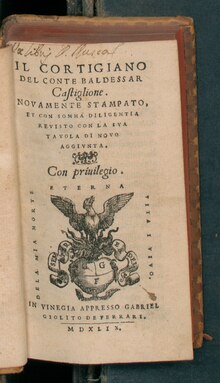 | |
| Language | Italian |
|---|---|
| Subject | Etiquette |
| Publisher | Aldine Press |
Publication date | 1528 |
The Book of the Courtier (Italian: Il Cortegiano [il korteˈdʒaːno]) by Baldassare Castiglione is a lengthy philosophical dialogue on the topic of what constitutes an ideal courtier or (in the third chapter) court lady, worthy to befriend and advise a prince or political leader. Inspired by the Spanish court during his time as Ambassador of the Holy See (1524–1529),[1] Castiglione set the narrative of the book in his years as a courtier in the Duchy of Urbino. The book quickly became enormously popular and was assimilated by its readers into the genre of prescriptive courtesy books or books of manners, dealing with issues of etiquette, self-presentation, and morals, particularly at princely, or royal courts, books such as Giovanni Della Casa's Il Galateo (1558) and Stefano Guazzo's The Civil Conversation (1574).[2] The Book of the Courtier was much more than that, however, having the character of a drama, an open-ended philosophical discussion, and an essay. It has also been seen as a veiled political allegory.[3]
The book offers a poignantly nostalgic evocation of an idealized milieu — that of the small courts of the High Renaissance which were vanishing in the Italian Wars — with a reverent tribute to the friends of Castiglione's youth. It pays tribute in particular to the chastely married Duchess Elisabetta Gonzaga of Urbino, to whom Castiglione had addressed a sequence of Platonic sonnets, and who died in 1526. The work was composed over the course of twenty years, beginning in 1508, and ultimately published in 1528 by the Aldine Press in Venice just before the author's death. An influential English translation by Thomas Hoby was published in 1561.
- ^ Castiglione 1901, p. 319.
- ^ Courtesy literature can be traced back to 13th century German and Italian writers. "Courtesy Literature", Encyclopædia Britannica Online, 2008.
- ^ See: W. R. Albury,Castiglione's Allegory: Veiled Policy in The Book of the Courtier (1528) (Routledge, 2014).